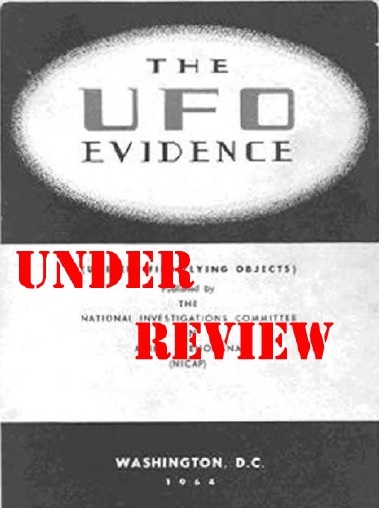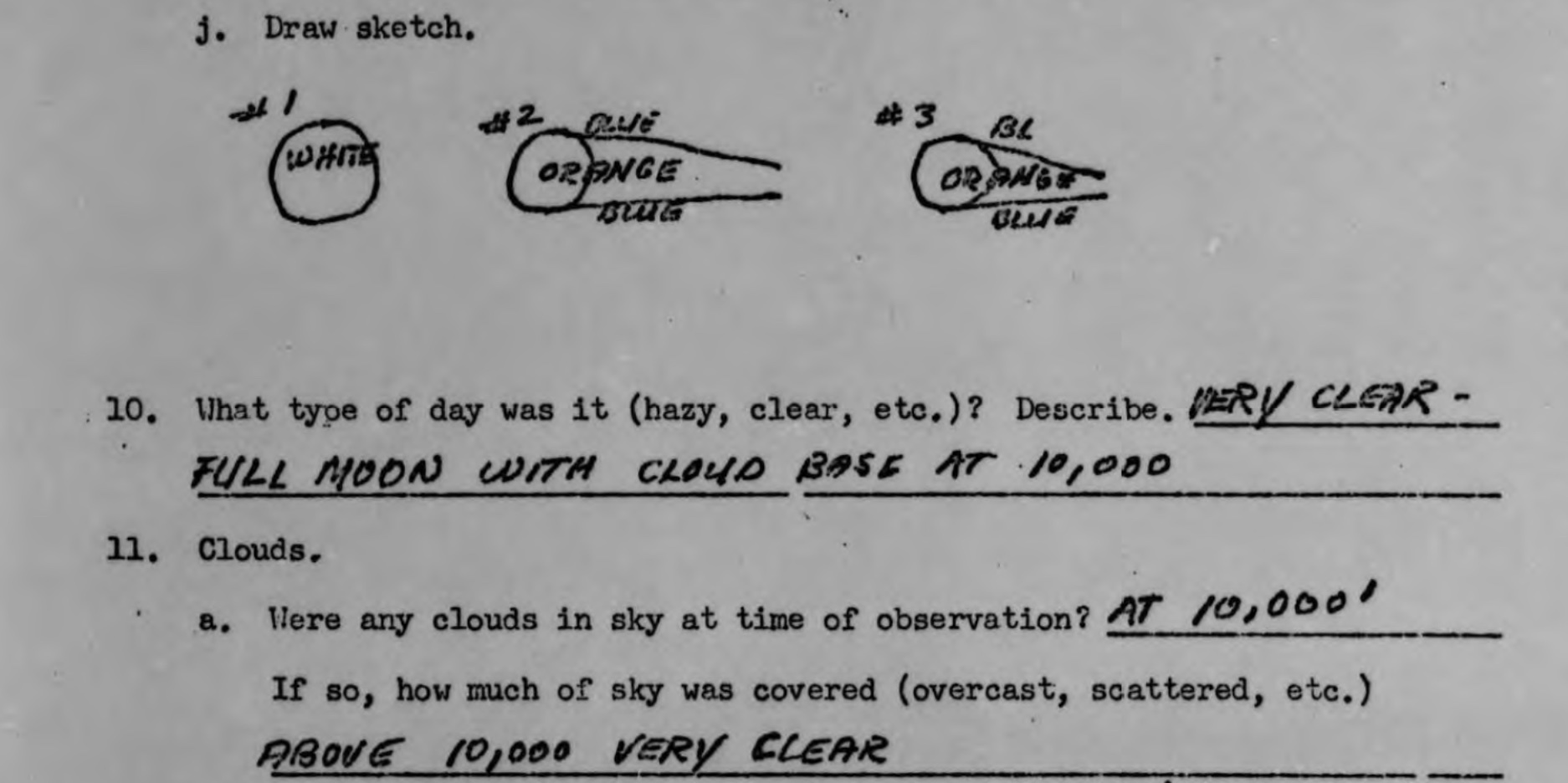25.09.2023

May 8, 1952 Atlantic Ocean off Jacksonville, Fla.
May 8, 1952--Atlantic Ocean off Jacksonville, Fla. Pan- American Airways pilot and copilot saw light, 10 times the size of a landing light, come head-on, streak past left wing. [V]1
I could not find the entry for this sighting in Section V.
Source material
While NICAP does not give us any additional information, the sighting can be found in the Blue Book files. It was also mentioned in Blue Book Special Report number 7 (Ap- pendix III). I could not find any reference to the event in the Newspaper archive. Ruppelt’s book, which may be the source for the NICAP entry, devotes three pages to the sighting. This is his description of the event:
One such message came in about 4:30 A.M. on May 8, 1952. It was from a CAA radio station in
Jacksonville, Florida, and had been forwarded over the Flight Service teletype net. I received
the usual telephone call from the teletype room at Wright-Patterson, I think I got dressed, and I went out and picked up the message. As I signed for it I remember the night man in the teletype
room said, “This is a lulu, Captain.”
It was a lulu. About one o’clock that morning a Pan-American airlines DC-4 was flying south toward Puerto Rico. A few hours after it had left New York City it was out over the Atlantic Ocean, about 600 miles off Jacksonville, Florida, flying at 8,000 feet. It was a pitch-black night; a high overcast even cut out the glow from the stars. The pilot and copilot were awake but really weren’t concentrating on looking for other aircraft because they had just passed into the San Juan Oceanic Control Area and they had been advised by radio that there were no other airplanes in the area. The copilot was turning around to look at number four engine when he noticed a light up ahead. It looked like the taillight of another airplane. He watched it closely for a few seconds since no other airplanes were supposed to be in the area. He glanced out at number four engine for a few seconds, looked back, and he saw that the light was in about the same position as when he’d first seen it. Then he looked down at the prop controls, synchronized the engines, and looked up again. In the few seconds that he had glanced away from the light, it had moved to the right so that it was now directly ahead of the DC-4, and it had increased in size. The copilot reached over and slapped the pilot on the shoulder and pointed. Just at that instant the light began to get bigger and bigger until it was “ten times the size of a landing light of an airplane.” It continued to close in and with a flash it streaked by the DC-4’s left wing. Before the crew could react and say anything, two more smaller balls of fire flashed by. Both pilots later said that they sat in their seats for several seconds with sweat trickling down their backs.
It was one of these two pilots who later said, “Were you ever traveling along the highway about 70 miles an hour at night, have the car that you were meeting suddenly swerve over into your lane and then cut back so that you just miss it by inches? You know the sort of sick, empty feeling you get when it’s all over? That’s just the way we felt.”
As soon as the crew recovered from the shock, the pilot picked up his mike, called Jacksonville Radio, and told them about the incident. Minutes later we had the report. The next afternoon Lieutenant Kerry Rothstien, who had replaced Lieutenant Metscher on the project, was on his way to New York to meet the pilots when they returned from Puerto Rico.
When Kerry talked to the two pilots, they couldn’t add a great deal to their original story. Their final comment was the one we all had heard so many times, “I always thought these people who reported flying saucers were crazy, but now I don’t know.”
When Lieutenant Rothstien returned to Dayton he triple-checked with the CAA for aircraft in the area—but there were none. Could there have been airplanes in the area that CAA didn’t know about? The answer was almost a flat “No.” No one would fly 600 miles off the coast without filing a flight plan; if he got into trouble or went down, the Coast Guard or Air Rescue Service would have no idea where to look.
Kerry was given the same negative answer when he checked on surface shipping.
The last possibility was that the UFO’s were meteors, but several points in the pilots’ story ruled these out. First, there was a solid overcast at about 18,000 feet. No meteor cruises along straight and level below 18,000 feet. Second, on only rare occasions have meteors been seen traveling three in trail. The chances of seeing such a phenomenon are well over one in a billion.
Some people have guessed that some kind of an atmospheric phenomenon can form a “wall of air” ahead of an airplane that will act as a mirror and that lights seen at night by pilots are nothing more than the reflection of the airplane’s own lights. This could be true in some cases, but to have a reflection you must have a light to reflect. There are no lights on an airplane that even approach being “ten times the size of a landing light.”
What was it? I know a colonel who says it was the same thing that the two Eastern Airlines’ pilots, Clarence Chiles and John Whitted, saw near Montgomery, Alabama, on July 24, 1948, and he thinks that Chiles and Whitted saw a spaceship.2
Brad Sparks also lists the case in his list of Blue Book Unknowns. His entry reads:
May 8, 1952. Atlantic, 600 miles E of Jacksonville, Florida (at 31°20’ N, 70° W). 2:27 a.m. (EST?) Pilot Capt. Cent and copilot 1st officer Gal- lagher of Pan Am Flight 203 flying DC-4 airliner at 8,000 ft on 180° heading from NYC to San Juan, Puerto Rico, saw brilliant white
approaching from the left below the solid overcast at 10,000 ft. and streak by the left [?] wing at 1/8 to 1/4 mile, followed by 2 smaller orange balls of fire. 3
After reading the Ruppelt and Sparks entry one would probably classify this as a true UFO. The Blue Book record card shows it orig- inally classified as “unknown” but then reclassified as a meteor. There is even a handwritten note at the bottom that states “Obvious meteor”! One wonders how one can classify this meteor if there was a solid overcast as stated by Sparks and Ruppelt. A closer examination of the Blue Book file explains why.
While the file contains several initial teletype messages regarding the sighting, as well as a summary, the most important piece of information is the form filled out by the Co-pilot.4 He took the time to actually complete the form properly and it clears up a great many things that were open to speculation in the summary/teletypes, which were not very specific.
-
The time was 0227 EDT (0627 Z). The teletype states it was 0534Z.
-
The object went from south to north and was at the same level as the aircraft. It appeared suddenly and lasted a few seconds before going out of the line of sight of the crew.
-
The object was actually three objects (See sketch). The first object was very bright (ten times the size of an aircraft landing light) and the two following it were smaller and appeared orange with blue edges.

-
The apparent altitude was 15,000 feet and was 1/8 to 1/4 mile off the port wing. The implication of this altitude estimate was the plane was also flying at 15,000 feet since he stated that they were both at the same altitude/level.
-
The weather was listed as “Very clear - Full moon with cloud base at 10,000”.
In his comments, the Co-pilot stated, “No similarity to meteor or any other familiar object or phenomenon. First object much whiter and brighter than landing light”.
The Teletype message reveals the flight was en route from New York to San Juan, Puerto Rico. Blue Book investigated by asking the Navy if they had any missile, or other, activity in the area. They replied there was none.
There is no additionally information in the file or in Special report number 7.
Analysis
This solution reveals itself once we read the Co-Pilot’s report. The aircraft was flying to the south and saw the object come from the south and pass off the port wing. The plane was at 15,000 feet, which was 5,000 feet ABOVE the overcast cloud cover. The UFO was composed of three “craft” with two fainter ones in trail behind the brighter object. The objects did not deviate course.
I agree with the handwritten note on the record card. This is an obvious meteor. It had all the characteristics with a straight level flight and short duration. The only reason Ruppelt classified this as unknown was probably because it reinforced his conclusions about Chiles-Whitted, which was also probably a meteor. I have no idea why he chose to say the aircraft was beneath the overcast, when the co-pilot stated they were flying in clear skies above the cloud layer. This was probably an extremely bright fireball that had fragmented into three pieces. This type of bright fragmenting meteor is unusual and can explain why the co-pilot felt it was something with which he was not familiar. Many people who see such meteors often make that kind of remark since they are used to seeing only meteors that quickly fade out and are not excessively bright.
Conclusion
Over the years, I have begun to question the reliability of Ruppelt’s accounts. Many of his entries appeared to be based on the files but sometimes omit key details or tend to exaggerate the exotic nature of these reports. I can only assume this was done in order to make mundane sightings appear more spectacular and unexplainable. By doing this, Ruppelt could sell his book to a wide audience wanted to hear all about UFO stories. The sad part about it is that subsequent UFO “researchers” accept Ruppelt as gospel instead of looking further. This event again demonstrates that Ruppelt’s accounts should be verified before considering them factual. This was probably a meteor and should be removed from the Weinstein catalog, NICAP’s UFO evidence, and Sparks’ list of Blue Book unknowns.
Quelle: SUNlite 3/2023

